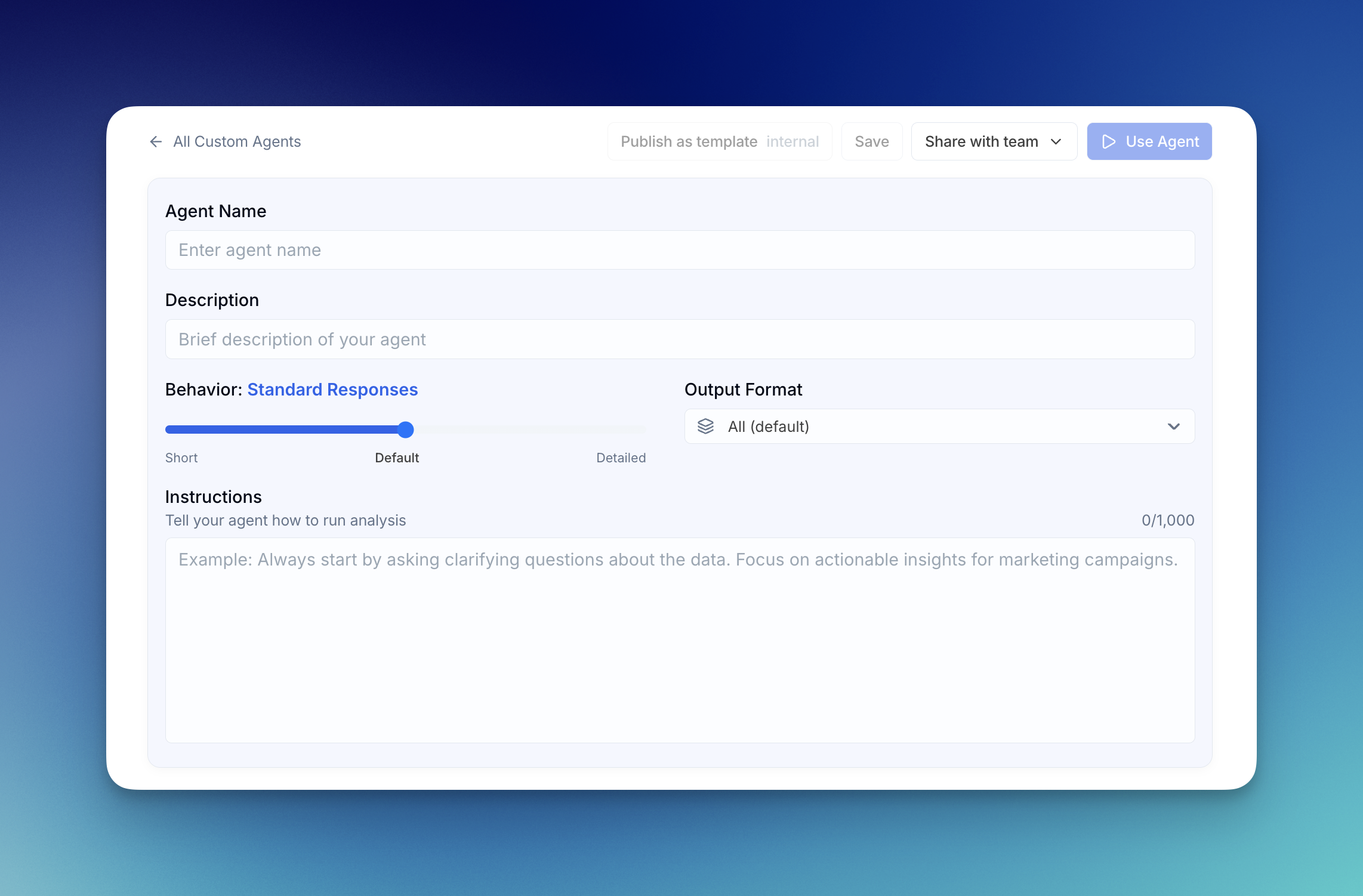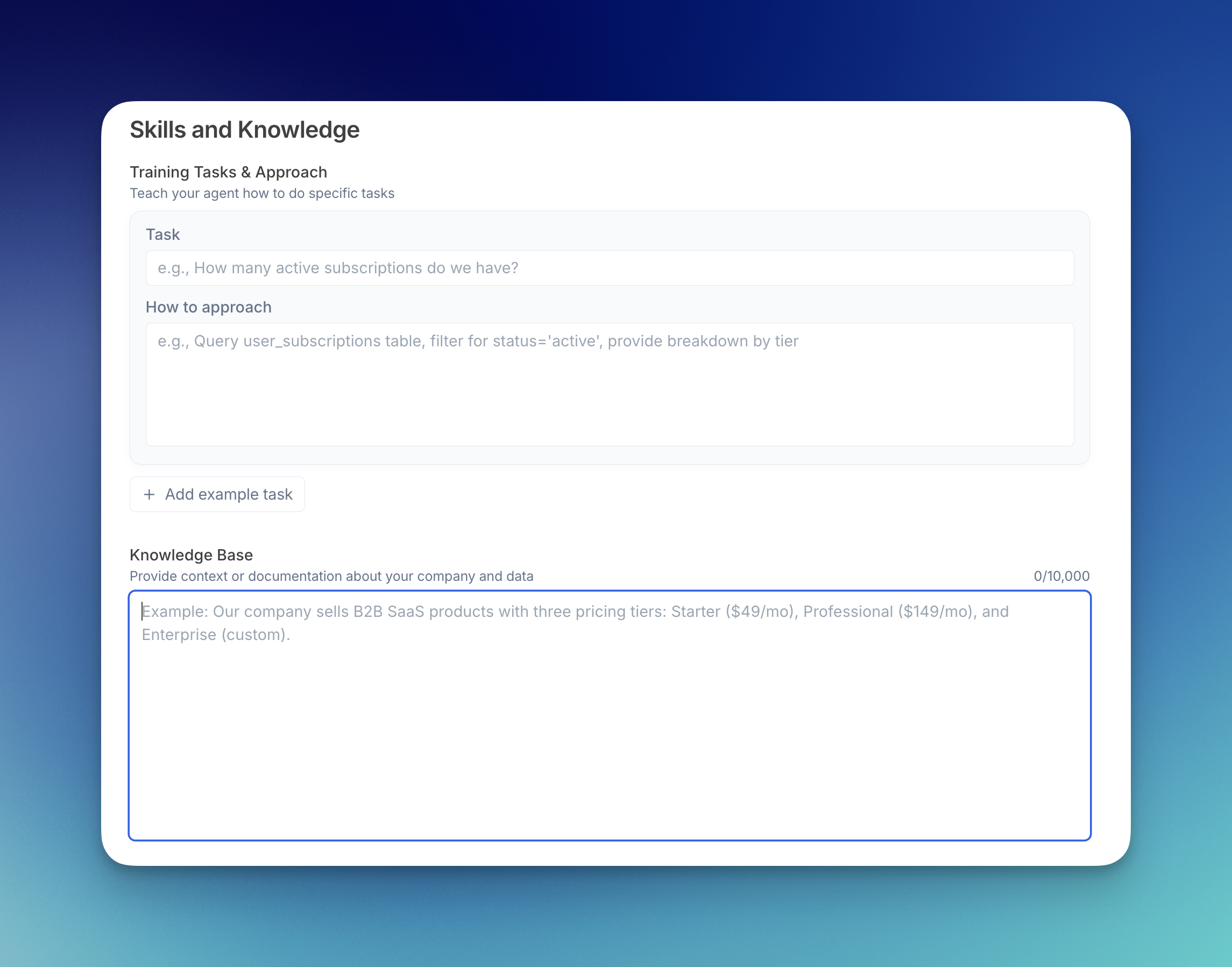Creating Your First Agent
1
Navigate to Custom Agents
Go to julius.ai/custom-agents or click Custom Agents in your sidebar menu, then click Create Agent.
2
Name Your Agent
Give your agent a descriptive name that reflects its purpose (e.g., “Marketing Analytics Expert” or “Financial Reporting Assistant”).
3
Configure Your Agent
Fill in the configuration fields to customize how your agent behaves and what it knows.
How Custom Agents Work
When you configure a custom agent, you’re building a specialized assistant that works within Julius’s context window. Here’s how all the pieces fit together:.png) Your Agent Configuration Lives in the System Prompt:
Your custom agent’s configuration—including Instructions, Training Tasks, and a curated version of your Knowledge Base—becomes part of Julius’s system prompt. This means every response is guided by your specific setup.
The Knowledge Base Curator:
Here’s where it gets smart: Your full knowledge base (up to 10,000 characters) stays separate. When you ask a question, a specialized Knowledge Base Curator Sub-Agent analyzes your message against your complete knowledge base and extracts only the relevant information. This curated subset is what gets added to the system prompt, keeping responses focused and efficient.
The Complete Picture:
Your agent combines:
Your Agent Configuration Lives in the System Prompt:
Your custom agent’s configuration—including Instructions, Training Tasks, and a curated version of your Knowledge Base—becomes part of Julius’s system prompt. This means every response is guided by your specific setup.
The Knowledge Base Curator:
Here’s where it gets smart: Your full knowledge base (up to 10,000 characters) stays separate. When you ask a question, a specialized Knowledge Base Curator Sub-Agent analyzes your message against your complete knowledge base and extracts only the relevant information. This curated subset is what gets added to the system prompt, keeping responses focused and efficient.
The Complete Picture:
Your agent combines:
- System Prompt: Your instructions, training tasks, and curated knowledge
- Chat History: Your ongoing conversation context
- All of Julius’s standard capabilities (code execution, visualizations, data analysis, etc.)
Configuration Options

Agent Name & Description
Agent Name: Choose a clear, descriptive name for your agent. Description: Write a brief description that explains what your agent does. This helps you and your team quickly identify the right agent for the task.Behavior Settings
Control how your agent responds with the behavior slider:- Short: Concise, to-the-point responses
- Standard (Default): Balanced responses with appropriate detail
- Detailed: Comprehensive responses with thorough explanations
Output Format
Choose what type of output your agent prioritizes:- All (default): Balanced approach to all output types
- Visualizations First: Prioritizes creating charts and graphs
- Files/DataFrames First: Focuses on data tables and exports
- Insights First: Emphasizes written analysis and takeaways
Instructions
Character Limit: 1,000 characters Instructions define your agent’s general methodology and approach to analysis. Think of this as your agent’s working philosophy that applies to every interaction. Example:Keep instructions focused on how to work rather than specific tasks. Save concrete examples for Training Tasks.
Training Tasks & Approach
 Training tasks teach your agent how to handle specific questions with concrete, step-by-step examples. When you ask a similar question later, your agent recognizes the pattern and applies what you taught it. You can add up to 5 training tasks.
Each task has two parts:
Training tasks teach your agent how to handle specific questions with concrete, step-by-step examples. When you ask a similar question later, your agent recognizes the pattern and applies what you taught it. You can add up to 5 training tasks.
Each task has two parts:
- Task: The question or request (e.g., “How many active subscriptions do we have?”)
- How to approach: Step-by-step instructions for completing this task
- Ensures consistency on repeated tasks
- Teaches best practices to your agent
- Reduces the need for detailed instructions each time
- Great for onboarding team members to your analytical standards
Training tasks provide examples, but your agent can still handle variations and new questions. These are learning examples, not strict rules.
Knowledge Base
Character Limit: 10,000 characters The knowledge base holds all the context about your company, data, and domain. Here’s the smart part: you don’t need to reference it manually. When you ask a question, Julius automatically reads through your knowledge base and summarizes only the relevant information needed for that specific question. This means your agent always has the right context without overwhelming it with unnecessary details. What to Include:- Company background and business model
- Data structure and key tables/fields
- Industry-specific terminology
- Important metrics and how they’re calculated
- Common data issues or quirks
- Relationships between different data sources
You can include up to 10,000 characters of context. Don’t worry about being too detailed - the automatic summarization ensures your agent only uses what’s relevant for each question.
Web Search
Toggle whether your agent can use web search to find current information beyond its training data. Useful for agents that need to reference current events, prices, or frequently changing information.Saving Your Agent
Once you’ve configured your agent:- Click Save to store your configuration
- Click Use Agent to activate it immediately and start a new chat
- Or click Share with Team to make it available to team members
You can edit and refine your agent at any time. As you learn what works best, update the configuration to improve performance.
